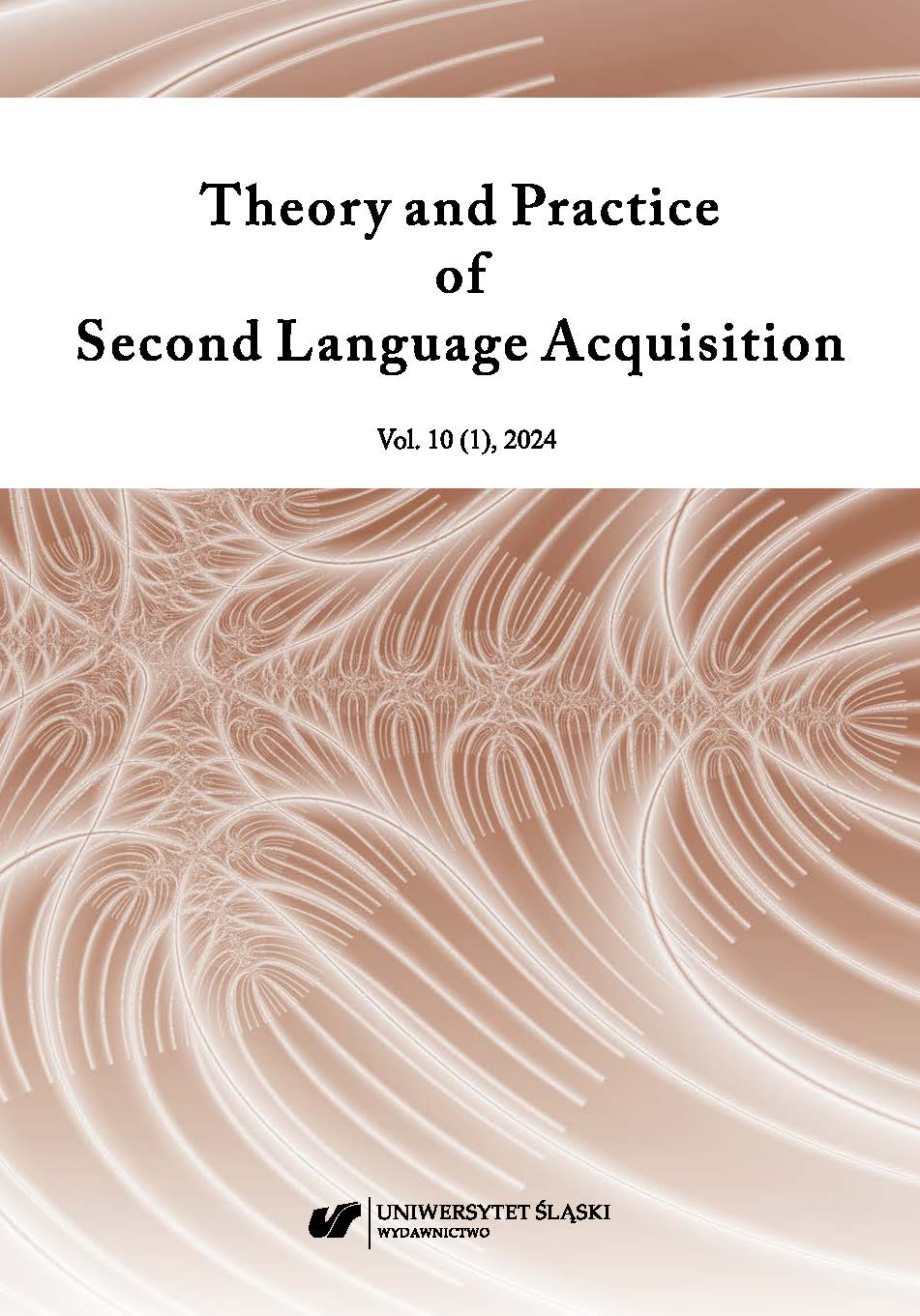Barnes, J. D. (2006). Early trilingualism: A focus on questions. Multilingual Matters.
Google Scholar
Cenoz, J. (2003). The additive effect of bilingualism on third language acquisition: A review. International Journal of Bilingualism, 7(1), 71–87.
Google Scholar
Chłopek, Z. (2011). Nabywanie języków trzecich i kolejnych oraz wielojęzyczność: Aspekty psycholingwistyczne (i inne). Wydawnictwo Uniwersytetu Wrocławskiego.
Google Scholar
Chłopek, Z. (2016). Early bilingualism and multilingualism: Parents’ and caregivers’ attitudes and observations. Peter Lang. https://doi.org/10.3726/978-3-653-06204-5
Google Scholar
D’Angelo, F., & Sorace, A. (2022). The additive effect of metalinguistic awareness in third or additional language acquisition. International Journal of Bilingual Education and Bilingualism, 25(10), 3551–3567. https://doi.org/10.1080/13670050.2022.2064710
Google Scholar
De Houwer, A. (2005). Early bilingual acquisition: Focus on morphosyntax and the separate development hypothesis. In J. F. Kroll & A. M. B. de Groot (Eds.), Handbook of bilingualism: Psycholinguistic approaches (pp. 30–48). Oxford University Press.
Google Scholar
De Houwer, A. (2009). Bilingual first language acquisition. Multilingual Matters.
Google Scholar
De Houwer, A. (2022). The danger of bilingual-monolingual comparisons in applied linguistic research. Applied Psycholinguistics, First View, 1–15. https://doi.org/10.1017/S014271642200042X
Google Scholar
Döpke, S. (1998). Competing language structures: The acquisition of verb placement by bilingual German-English children. Journal of Child Language, 25(3), 555–584. https://doi.org/10.1017/S0305000998003584
Google Scholar
Gatto, D. (2004). Ein Kind–drei Sprachen: Bericht einer longitudinalen Fallstudie. In B. Hufeisen & N. Marx (Eds.), Beim Schwedischlernen sind Englisch und Deutsch ganz hilfsvoll. Untersuchungen zum multiplen Sprachenlernen (pp. 163–176). Peter Lang.
Google Scholar
Genesee, F., & Nicoladis, E. (2009). Bilingual first language acquisition. In E. Hoff & M. Shatz (Eds.), Blackwell handbook of language development (pp. 324–342). Wiley-Blackwell.
Google Scholar
Gósy, M. (2007). Speech perception processing in first and second language in bilinguals and L2 learners. In Z. Lengyel & J. Navracsics (Eds.), Second language lexical processes: Applied linguistic and psycholinguistic perspectives (pp. 39–59). Multilingual Matters.
Google Scholar
Grosjean, F. (1989). Neurolinguists, beware! The bilingual is not two monolinguals in one person. Brain and Language, 36 (1), 3–15.
Google Scholar
Herdina, P., & Jessner, U. (2002). A dynamic model of multilingualism: Perspectives of change in psycholinguistics. Multilingual Matters.
Google Scholar
Hoff, E., Core, C., Place, S., Rumiche, R., Senor, M., & Parra, M. (2012). Dual language exposure and early bilingual development. Journal of Child Language, 39, 1–27. https://doi.org/10.1017/S0305000910000759
Google Scholar
Hoffmann, C., & Stavans, A. (2007). The evolution of trilingual codeswitching from infancy to school age: The shaping of trilingual competence through dynamic language dominance. International Journal of Bilingualism, 11(1), 55–72. https://doi.org/10.1177/13670069070110010401
Google Scholar
Jessner, U. (2006). Linguistic awareness in multilinguals: English as a third language. Edinburgh University Press.
Google Scholar
Johnsen, R. V. (2022). “Quiero juksar en la julaftenito”—Playfulness and metalinguistic awareness in translingual family interactions. Multilingua, 41(1), 57–83. https://doi.org/10.1515/multi-2019-0120
Google Scholar
Legacy, J., Zesiger, P., Friend, M., & Poulin-Dubois, D. (2018). Vocabulary size and speed of word recognition in very young French-English bilinguals: A longitudinal study. Bilingualism, 21(1), 137–149. https://doi.org/10.1017/S1366728916000833
Google Scholar
Li, W. (2018). Translanguaging as a practical theory of language. Applied Linguistics, 39(1): 9–30. https://doi.org/10.1093/applin/amx039
Google Scholar
Li, W., & Hua, Z. (2015). Challenges of multilingualism to the family. In U. Jessner-Schmid & C. J. Kramsch (Eds.), The multilingual challenge: Cross-disciplinary perspectives (pp. 21–38). Walter de Gruyter Mouton. https://doi.org/10.1515/9781614512165-002
Google Scholar
Montanari, S. (2009). Pragmatic differentiation in early trilingual development. Journal of Child Language, 36, 597–627. https://doi.org/10.1017/S0305000908009112
Google Scholar
Müller, N., & Hulk, A. (2001). Crosslinguistic influence in bilingual language acquisition: Italian and French as recipient languages. Bilingualism: Language and Cognition, 4(1), 1–21. https://doi.org/10.1017/S1366728901000116
Google Scholar
Navracsics, J. (1998). The acquisition of Hungarian by trilingual children. Unpublished doctoral thesis, Janus Pannonius University of Pécs, Hungary.
Google Scholar
Oller, D. K., Pearson, B. Z., & Cobo-Lewis, A. B. (2007). Profile effects in early bilingual language and literacy. Applied Psycholinguistics, 28 (2), 191–230. https://doi.org/10.1017/S0142716407070117
Google Scholar
Ordóñez, C. L. (2004). EFL and native Spanish in elite bilingual schools in Colombia: A first look at bilingual adolescent frog stories. Bilingual Education and Bilingualism, 7(5), 449–474. https://doi.org/10.1080/13670050408667825
Google Scholar
Paradis, M. (2004). A neurolinguistic theory of bilingualism. John Benjamins.
Google Scholar
Paradis, M. (2009). Declarative and procedural determinants of second languages. John Benjamins.
Google Scholar
Paradowski, M., & Michałowska, M. (2016). Establishing a bilingual home: Parents’ perspective on the effectiveness of the adopted communication strategies. Lingwistyka Stosowana, 17(2), 43–65.
Google Scholar
Peal, E., & Lambert, W. E. (1962). The relation of bilingualism to intelligence. Psychological Monographs: General and Applied, 76(27), 1–23.
Google Scholar
Safont Jordà, M. P. (2003). Metapragmatic awareness and pragmatic production of third language learners of English: A focus on request acts realizations. International Journal of Bilingualism, 7(1), 43–69.
Google Scholar
Sharwood Smith, M., & Kellerman, E. (1986). Crosslinguistic influence in second language acquisition: an introduction. In E. Kellerman & M. Sharwood Smith (Eds.), Cross-linguistic influence in second language acquisition (pp. 1–9). Pergamon.
Google Scholar
Thomas, J. (1988). The role played by metalinguistic awareness in second and third language learning. Journal of Multilingual and Multicultural Development, 9(3), 235–246.
Google Scholar
Tomasello, M. (1999). The cultural origins of human cognition. Harvard University Press.
Google Scholar
Ullman, M. T. (2001). The neural basis of lexicon and grammar in first and second language: the declarative/procedural model. Bilingualism: Language and Cognition, 4(1), 105–122. https://doi.org/10.1017/S1366728901000220
Google Scholar
van Dijk, C., van Wonderen, E., Koutamanis, E., Kootstra, G. J., Dijkstra, T., & Unsworth, S. (2022). Cross-linguistic influence in simultaneous and early sequential bilingual children: A meta-analysis. Journal of Child Language, 49(5), 897–929. https://doi.org/10.1017/S0305000921000337
Google Scholar
Vásquez Carranza, L. M. (2009). Cognitive advantages of balanced bilingualism. Revista Pensamiento Actual, 9(12–13), 69–78.
Google Scholar
Verschueren, J. (2000). Notes on the role of metapragmatic awareness in language use. Pragmatics, 10(4), 439–456.
Google Scholar


 https://doi.org/10.31261/TAPSLA.14547
https://doi.org/10.31261/TAPSLA.14547

 10.31261/tapsla
10.31261/tapsla